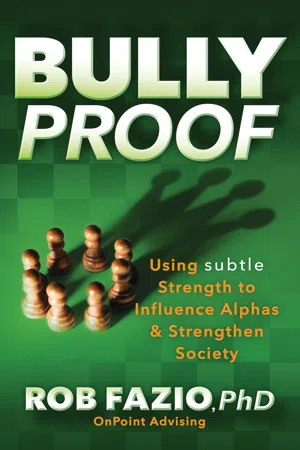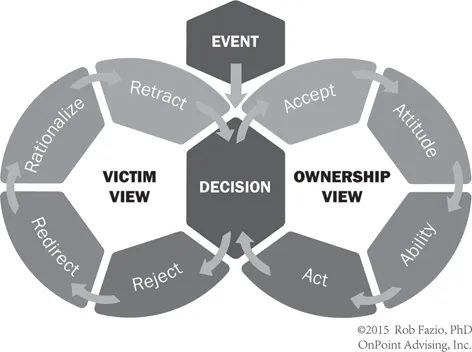![]()
Part 1
BullyProof Yourself and Others
![]()
CHAPTER 1
Value-Based Power: A Balanced Approach to Influence
A certain executive in a tech company was known for driving results. The board of directors and the rest of the C-suite viewed him as an excellent leader because his teams consistently brought innovative products to market and hit their metrics every quarter. The problem was that he achieved these results by micromanaging his team, and the team was slowly and silently burning out. His timelines became unrealistic as he expected his employees to be working at their peak every moment of every day. When team members couldn’t deliver according to his expectations, he typically grew impatient and often yelled out of frustration.
The result was a working climate of fear, which created resentment. Employees were responding to this type of dominance by becoming passive and trying to avoid the executive. This created a cycle where the executive would think less and less of the team and mistake their disengagement as lack of competence.
One of the executive’s most talented team members was now dreading going to work. She felt she had lost her creativity and motivation and was even wondering if she was getting depressed. She certainly wasn’t going to talk to her boss about it because she feared losing her job, but she finally found the courage to talk to a coworker.
She was surprised to discover the rest of her team was feeling the same way. Among the team, self-doubt shifted to anger and blame. The colleagues realized they had no space to create the level of results their boss was demanding, and they decided the problem was their boss’s dysfunctional leadership. He just didn’t understand what it took to be creatively productive. One by one, they left the company for what they believed would be a more supportive work environment.
Meanwhile, the executive had no idea how the team members felt because he assumed everyone was like him: driven, achievement oriented, and focused on getting things done regardless of the cost. In their exit interviews, he received no feedback about his management style except for vague statements about how they had learned a lot at this organization but were ready to move on. He attributed the turnover to the fact that nobody stayed in one job for long anymore. Obviously, they couldn’t take the pressure of working at a top-tier organization, and he would just need to find others who could.
The Cost of Dysfunctional Power
Whom did you relate with more: the executive or the team members? Or both?
As we saw in the introduction, the cost of dysfunctional power is staggering. Not only does it cost employees in terms of health, self-esteem, productivity, and steady employment, it costs the dysfunctionally dominant supervisor in terms of stress, turnover, and talent lost. Often times it ends up diminishing the executive’s credibility and derailing the executive’s career.
As we talk about the cost of dysfunctional power, I want to acknowledge the pioneering work of others. One of the greatest thought leaders in the field of organizational psychology is Adam Grant of Wharton. He doesn’t know it, but his work always influences my thinking, rethinking, and advising. I sent him an email out of the blue asking him about any work he knew of related to bullying in the workplace. He was gracious enough to respond and told me about the work of Bob Sutton, who has done incredible work on abusive power and its impact on people and business. Sutton’s book The No A$$hole Rule: Building a Civilized Workplace and Surviving One That Isn’t helped me better understand the true costs of dysfunction and abusive power, and he is truly a pioneer in this space.10
I can’t put this strongly enough: If you’re keeping someone around who’s a high performer but dysfunctionally dominant, you may think you’re driving performance, but you’re actually hurting productivity. Any positive results you can see are decimated by the damage you can’t see.
On the other hand, if you’re experiencing dysfunctional dominance at your workplace, there’s a tremendous cost to doing nothing as well.
I want you to know you have another choice: You can choose to own your power. You can choose to be a leader in these dysfunctional situations and influence them in a positive way.
Own Your Power
Regardless of our personality, at some point all of us will fall into a victim mentality. It happens to everyone, and it’s normal. The keys are to (1) recognize when we have fallen into a victim mentality and (2) know how to shift to an ownership mentality so we don’t make tough situations worse. I also want you to be able to identify this process in others so you can help them help themselves, creating a positive cycle of confidence and initiative.
When we are in a victim mentality, our feelings become facts and we forget we have the ability to positively influence any situation. Believing that you don’t have any control can be very dangerous, as can only focusing on what you can’t control. When you focus on what is happening to you rather than what you can make happen, you miss out on opportunities and train your mind to give up rather than have hope.
In every situation you have a choice: Am I going to be a victim, or am I going to be an owner?
Our minds are very powerful, and we can either help ourselves by guiding our thoughts or hurt ourselves by letting them go on autopilot. Here is a roadmap that outlines two pathways: the victim cycle, where things happen to you, and the ownership cycle, where you make things happen.
Both cycles start at the same place, with an event, and they end up in very different places with different outcomes.11
Figure 1.1. The Pathway to Ownership
First, an event occurs. With every event, we have a decision to make: Will we reject what has happened and resist it, or will we accept what has happened and do what we can to improve the situation?
This decision, reject or accept, sets the cycle of victim or ownership in motion.
If you choose to reject the event and resist what is happening, the victim cycle begins, where we focus on what others aren’t doing rather than what we can be doing to adapt or get ahead. We redirect and blame, talking about what is wrong rather than what can go right. We rationalize, explaining to ourselves and others why our victim mentality is the best response to the situation. We may even end up creating a victim alliance, where others join our pity party and enter into the victim cycle with us. Finally, we retract, where we disengage and “leave without leaving.” Eventually we may leave physically too, like the team members in our example.
However, if you accept the event instead of rejecting it, you enter the ownership cycle. Accepting an event doesn’t mean agreeing with it; it just means you’re ready to deal with it and move towards action rather than reaction. When you accept what has happened, your attitude becomes more positive, which provides more fuel for action. It also increases your ability to move forward and develop new skills to adjust and adapt. And this increased ability results in more action, where you continue to act intentionally and focus forward.
Even if you fall into the victim cycle, you don’t have to stay there. You can decide at any time to accept your situation, rather than reject it, and enter the ownership cycle.
Over time you can train yourself to accept situations more quickly and, therefore, take ownership of your power more often and become more action oriented even in times of crisis. We’ll talk more about how to train your brain to take ownership throughout the book.
What are the benefits of choosing to own your power? What positive results do you want to create for yourself, for others, for your organization, for society?
What is the cost of choosing not to own your power?
Once you become skilled at taking ownership of your power and influence, it’s time to take responsibility for your impact. To do that, I invite you to consider a new vision of power: Value-Based Power.
Value-Based Power
I attended an event where a speaker was talking about power. The speaker asked the question, “How do you feel when you don’t have power?” The audience responded with a host of responses, such as defeated, demotivated, beaten, angry, lost, disenfranchised. I raised my hand and responded, “Motivated!”
“When you are powerless?” the speaker asked with a puzzled look of disapproval.
I responded, “Yes, if I don’t have power, I am motivated to get it and share it.” With a little laughter, I added, “Perhaps it has something to do with being Sicilian.”
Power is an important part of business and life. When we don’t have power, we often lack motivation. When we do have power, we have the opportunity to do a lot of good, and we also run the risk of doing potential harm.
Positional authority also magnifies the impact of someone’s power. The power that comes with someone’s position can be used to elevate people or beat them down.
When we experience dysfunctional power situations over and over, it’s easy to believe power is bad. But power isn’t inherently bad. It’s just often misused.
The type of power you exhibit is directly related to your intentions and motivations. Value-Based Power (VBP) is an approach toward power where you intentionally use your influence to act according to your values, balanced across four areas: self, others, organization, and society. Our values guide us and give us strength and courage to act, even in challenging situations.
Figure 1.2. Value-Based Power
This book isn’t just about influencing alphas; it’s about fully owning your power so you can use it for good. In fact, connecting your values and your influence can give you courage you may not otherwise have access to. For examp...


